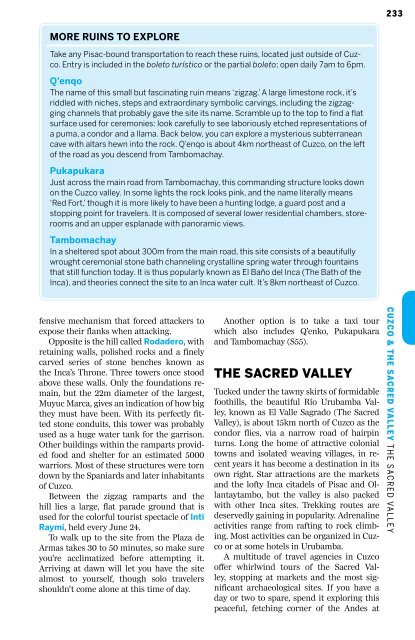peru-8-cuzco-sacred-valley
You also want an ePaper? Increase the reach of your titles
YUMPU automatically turns print PDFs into web optimized ePapers that Google loves.
233<br />
MORE RUINS TO EXPLORE<br />
Take any Pisac-bound transportation to reach these ruins, located just outside of Cuzco.<br />
Entry is included in the boleto turístico or the partial boleto; open daily 7am to 6pm.<br />
Q’enqo<br />
The name of this small but fascinating ruin means ‘zigzag.’ A large limestone rock, it’s<br />
riddled with niches, steps and extraordinary symbolic carvings, including the zigzagging<br />
channels that probably gave the site its name. Scramble up to the top to find a flat<br />
surface used for ceremonies: look carefully to see laboriously etched representations of<br />
a puma, a condor and a llama. Back below, you can explore a mysterious subterranean<br />
cave with altars hewn into the rock. Q’enqo is about 4km northeast of Cuzco, on the left<br />
of the road as you descend from Tambomachay.<br />
Pukapukara<br />
Just across the main road from Tambomachay, this commanding structure looks down<br />
on the Cuzco <strong>valley</strong>. In some lights the rock looks pink, and the name literally means<br />
‘Red Fort,’ though it is more likely to have been a hunting lodge, a guard post and a<br />
stopping point for travelers. It is composed of several lower residential chambers, storerooms<br />
and an upper esplanade with panoramic views.<br />
Tambomachay<br />
In a sheltered spot about 300m from the main road, this site consists of a beautifully<br />
wrought ceremonial stone bath channeling crystalline spring water through fountains<br />
that still function today. It is thus popularly known as El Baño del Inca (The Bath of the<br />
Inca), and theories connect the site to an Inca water cult. It’s 8km northeast of Cuzco.<br />
fensive mechanism that forced attackers to<br />
expose their flanks when attacking.<br />
Opposite is the hill called Rodadero, with<br />
retaining walls, polished rocks and a finely<br />
carved series of stone benches known as<br />
the Inca’s Throne. Three towers once stood<br />
above these walls. Only the foundations remain,<br />
but the 22m diameter of the largest,<br />
Muyuc Marca, gives an indication of how big<br />
they must have been. With its perfectly fitted<br />
stone conduits, this tower was probably<br />
used as a huge water tank for the garrison.<br />
Other buildings within the ramparts provided<br />
food and shelter for an estimated 5000<br />
warriors. Most of these structures were torn<br />
down by the Spaniards and later inhabitants<br />
of Cuzco.<br />
Between the zigzag ramparts and the<br />
hill lies a large, flat parade ground that is<br />
used for the colorful tourist spectacle of Inti<br />
Raymi, held every June 24.<br />
To walk up to the site from the Plaza de<br />
Armas takes 30 to 50 minutes, so make sure<br />
you’re acclimatized before attempting it.<br />
Arriving at dawn will let you have the site<br />
almost to yourself, though solo travelers<br />
shouldn’t come alone at this time of day.<br />
Another option is to take a taxi tour<br />
which also includes Q’enko, Pukapukara<br />
and Tambomachay (S55).<br />
THE SACRED VALLEY<br />
Tucked under the tawny skirts of formidable<br />
foothills, the beautiful Río Urubamba Valley,<br />
known as El Valle Sagrado (The Sacred<br />
Valley), is about 15km north of Cuzco as the<br />
condor flies, via a narrow road of hairpin<br />
turns. Long the home of attractive colonial<br />
towns and isolated weaving villages, in recent<br />
years it has become a destination in its<br />
own right. Star attractions are the markets<br />
and the lofty Inca citadels of Pisac and Ollantaytambo,<br />
but the <strong>valley</strong> is also packed<br />
with other Inca sites. Trekking routes are<br />
deservedly gaining in popularity. Adrenaline<br />
activities range from rafting to rock climbing.<br />
Most activities can be organized in Cuzco<br />
or at some hotels in Urubamba.<br />
A multitude of travel agencies in Cuzco<br />
offer whirlwind tours of the Sacred Valley,<br />
stopping at markets and the most significant<br />
archaeological sites. If you have a<br />
day or two to spare, spend it exploring this<br />
peaceful, fetching corner of the Andes at<br />
Cuzco & the Sacred Valley 8 T H E S AC R E D VA L L E Y


